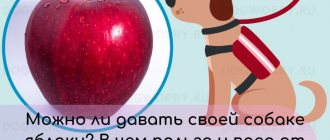Experienced dog breeders know how important it is to choose the right diet for their beloved pet, because the health, well-being and external grooming of the animal depend on nutrition.
When selecting proteins and beneficial amino acids for feeding an animal, the question arises: what kind of fish can be given?
The market sells healthy fish varieties that contain the required amount of necessary elements, but there are also those breeds that absolutely cannot be added when calculating the pet menu.
Is fish necessary in a dog's diet?
Modern pet owners believe that 1-2 types of meat are unable to replenish all the vitamins, microelements and amino acids necessary for health.
Therefore, adding fish to a dog’s diet is always justified, although it is not mandatory. Seafood is high in omega-3 and omega-6 fatty acids: they are needed for healthy skin and bones, prevent inflammation and support metabolism.
Fish contains a lot of:
- vitamins A, D and E;
- phosphorus;
- iodine;
- magnesium;
- sulfur.
Briefly about the main thing
- Fish is a nutritious, healthy food for dogs.
- It should not be used as the main source of protein; excess upsets the balance of nutrients and microelements.
- Dogs digest boiled fish worse than raw fish; if there is little of it in the diet, then it is better to simply freeze the product.
- A product with up to 8% fat content is more beneficial for dogs as a source of polyunsaturated fatty acids.
- Large breed dogs can eat fish with the head and small bones, small breeds can eat fish that has been thoroughly cleaned or minced through a meat grinder.
- Canned, smoked, dried, salted delicacies are contraindicated for dogs.
What type of fish is your dog’s favorite, which one does he eat more readily: river or sea? Share in the comments what fish dishes you prepare for your pet.
Did you like the article? Share it with your friends on social media. networks. This will help them get useful information and support our project.
Potential Harmfulness of Fish to Dogs
Fish is healthy for dogs, but it can be harmful to health if not prepared correctly. Without heat treatment, this product can cause poisoning or cause infection with worms.
Fish for dogs must be properly cooked.
Helminthiasis
A responsible owner treats the animal for parasites every 3 months, but the risk of developing dangerous diseases due to worms remains.
It is difficult to remove them with a one-time dose of the appropriate drug, and such drugs do not have any effect on the larvae.
Toxic substances
A toxin called trimethylamine oxide poses a great danger to animals. Its accumulation in the dog’s body leads to a decrease in the absorption of iron, which is why puppies grow poorly, and young females (up to a year) develop infertility. Even healthy adults begin to suffer from anemia.
Harmful enzymes
In addition to trimethylamine oxide, you should be wary of thiaminase. It not only interferes with the absorption of nutrients, but also destroys vitamin B1, without which the dog’s normal functioning is impossible. Chronic thiamine deficiency leads to paralysis and impaired cardiac function.
Stale product
Only spoiled fish is more dangerous than raw fish, because... it can cause acute poisoning, accompanied by severe intoxication, vomiting and diarrhea. These symptoms together cause dehydration. Without timely help, the animal may die.
Stale fish can cause poisoning.
Poisonous varieties
Just like people, pets should not eat:
- fugu;
- toad fish;
- scorpionfish;
- Katran shark;
- wart;
- sea dragon;
- inimikusa.
Is it possible to have herring
Herring is a fish accessible to any budget and therefore a frequent guest on our table. It is not surprising that herring often ends up in a dog’s bowl, because it is a source of many useful substances. It contains vitamins and minerals, amino acids and omega-3. However, herring has fatty meat, which stops many pet owners. Therefore, it is recommended to give it rarely, giving preference to other types of fish.
Important!
Under no circumstances should you feed your dog salted, pickled herring or canned food. Salt is harmful to dogs, as are other spices and preservatives.
It is also not recommended to give raw fish, the reason for this is the possible presence of parasites in it. Most marine fish species are infected with anisakids. If you give your dog freshly caught herring, the worms will enter the animal’s body, where they can live for a long time, manifesting themselves in allergic reactions or signs of poisoning. Parasites die at low temperatures, but it is best to feed your pet fish after boiling it first.
What fish can and cannot be given to dogs?
Many foods that are considered delicacies for humans cause poisoning in dogs and cause the development of dangerous diseases. If you want to diversify your pet's diet, be sure to study the list of fish varieties that are safe for pets.
Freshwater
This option is unlikely to be suitable for a picky pet. However, if your pet is interested in freshwater fish, it can be added to the diet. It is better to choose red varieties, such as trout, salmon, nelma or chum salmon.
Freshwater fish can be added to your dog's diet.
Remember that river and lake inhabitants are always infected with helminths, so it is absolutely forbidden to give such products without heat treatment. Simply pouring boiling water over the fish is also not enough.
Marine
For gourmets, sea fish is more suitable, because...
it has a more pronounced aroma and taste and is healthier than freshwater due to its high content of iodine and phosphorus. Another argument in favor of such a product is that there is less risk of becoming infected with helminths. In marine fish, anisakids are more common, which do not take root well in dogs. Feeding such meat is convenient for owners: it is easier to remove bones from it than from river varieties.
After cooking, the fillet itself separates from the backbone and ribs, so you don’t need to spend a lot of time cutting the fish.
Seafood
If the animal is prone to allergies, you will have to forget about any seafood. For those who do not have food intolerance, the following can be given as a treat:
- shrimp;
- oysters;
- crayfish
The dog is given shrimp as a treat.
Animals without food intolerance can consume such delicacies. But it is better to avoid raw seafood. They need to be boiled for 15–20 minutes, then added to porridge or given as a treat.
You should not feed your dog lobster or crab. Their consumption even in small quantities can cause severe poisoning. Even with the listed products, which are relatively safe, you need to be careful: you can treat your pet with them no more than once a week and in very small quantities.
What to do if things get bad?
Herring can only harm a dog if it has eaten a large amount uncontrollably. Herring is a fatty fish and the dog may experience vomiting or intestinal upset.
The most common cause of diarrhea is overeating. You can call your veterinarian or take action yourself and give your dog anti-diarrhea medication.
Got a bone stuck or choked
Every dog owner knows that before giving fish, it must be cleaned of fins, head, entrails and especially large bones. If your pet somehow managed to swallow a bone and choked, you will understand it immediately. He will begin to salivate profusely and cough slightly. Your actions:
- Check the animal's mouth, it is possible that the bone is in sight.
- Do not try to induce vomiting. Spasms can cause the bone to go deeper.
- You should also not give a laxative if there is concern that the bone is in the stomach or intestines.
- If the gastrointestinal tract is damaged, diarrhea mixed with blood will appear. You urgently need to contact a specialist.
In any case, if you have any suspicions, you are concerned and the dog is not feeling well, go to a specialist. You should not self-medicate or remove bones yourself.
Types of fish: which one can be given to dogs
Not only its value for the body depends on how food is prepared. If the product is not properly processed, it can be fatal to the dog. Therefore, every owner needs to know what kind of fish dogs can eat. This will prevent health problems associated with poor nutrition.
Raw
Raw fish is dangerous for dogs. At best, consuming such a product can cause stomach and intestinal upset. However, the consequences can be more severe: even paralysis and death.
Raw fish can be dangerous.
The danger also lies in helminths, which infect all freshwater fish. Treatment may take a long time. If the invasion is not diagnosed on time, it will lead to more significant health problems.
It is also not recommended to eat sea fish raw. In small quantities it is unlikely to cause the development of dangerous diseases. But systematic feeding of such a product will lead to the accumulation of thiaminase and trimethylamine oxide in the dog’s body. Therefore, any owner who values his pet should spend 15–20 minutes cooking before delighting him with such a delicacy.
Boiled
This method of processing fish is preferable because... During the cooking process, all dangerous substances and enzymes are destroyed. Helminths also die at high temperatures.
Dried
Fish prepared this way is not suitable for dogs. However, in rare cases it can be used as a treat. But, before giving this product to your pet, make sure that no salt was used during drying. Otherwise, the idea will have to be abandoned.
Dried fish is not suitable for dogs.
Smoked
Giving your dog smoked food is prohibited if spices were used for cooking. If there is no salt or other seasonings, it is acceptable to treat your pet to such fish. But you can eat no more than 10% of your daily food intake per day.
With bones
The dog is unable to chew the bones of sea creatures to a safe state, so you will have to remove the spine and ribs yourself. It is better to get rid of the tail and fins, which can scratch the palate, get stuck in the teeth and damage the esophagus.
Salty fish
This product is prohibited for consumption by pets. Eating salted fish can cause the death of a dog, so experimenting with such a delicacy is not recommended. Even in small quantities, this food can cause the development of dangerous pathologies of the kidneys and liver.
Giving salted fish is strictly prohibited.
Human canned food
Since spices, including salt, are often added to semi-finished products, such food is not suitable for pets. Regardless of the type of canned fish, feeding it to your dog is prohibited.
In addition to seasonings, fat and oil, which are abundant in all such products, are dangerous.
Fish heads
Veterinarians recommend using such products for cooking broth. Occasionally they can be used as a treat. However, fish heads are not suitable for constant feeding, because... They have low energy value and contain a lot of phosphorus and B vitamins.
Fish heads contain a lot of phosphorus.
Popular questions
How to teach a dog to fish?
This is easiest to do in puppyhood. Start accustoming your dog to low-fat varieties from 4 to 5 months of age, give this product little by little, monitor for possible allergic reactions and signs of indigestion. Remember, allergies to raw fish are less common.
What kind of fish can a dog with allergies eat?
- low-fat river and white sea salt (gives the dog hypoallergenic protein);
- fish not affected by “herring disease” - anisakidosis (allergies are caused by helminth toxins);
- raw, fresh frozen.
Red - trout, salmon, salmon - on the contrary, is dangerous for dogs with allergies.
Don’t forget about dry “fish” food of super premium and higher classes. As a rule, they are positioned as hypoallergenic.
Rules for feeding dogs with fish products
When feeding natural products to a dog's diet, veterinarians advise adding fish. But in order to keep your pet healthy, it is important to consider not only the cooking method - the food must be balanced.
At what age can it be introduced into the diet?
Most dogs digest fish easily, so it is considered a dietary food along with lamb, rabbit, turkey and duck. Since this protein source is minimally likely to cause gastrointestinal upset, it can be given even to puppies who are starting to eat their first adult food. However, this must be done carefully, because... even dietary muscle tissue can trigger allergies.
How much to give
The fish feeding rate is calculated individually. Not only the physical activity and age of the dog plays a role, but also the fat content of the selected product. For example, beluga, salmon, eel, mackerel or stellate sturgeon should be given in doses. These varieties are high in omega-3 and omega-6 acids. Although they are considered beneficial, an excess of these substances in the body causes calcium deposition on bone tissue, impaired renal and gastrointestinal function, and impaired blood clotting.
Beluga should be given in doses.
Lenten varieties can replace 1 full dog dinner 2 times a week. Fish should be given in the same amount as red meat. It is necessary to add carbohydrates in the form of rice or millet to protein foods. You can supplement the diet with vegetables or fruits, but veterinarians recommend giving them in a separate feeding. It is best to leave the vitamins for the morning (for example, with cottage cheese), and in the evening give the dog porridge with a rich source of protein.
Dry food based on seafood
Some breeders feed their dogs not regular food, but dry food that contains seafood.
This option is acceptable, but provided that the products are purchased in a super premium class. This “drying” contains all the necessary elements, microelements, vitamins and additives. The food is balanced and suitable for all four-legged animals. You can choose food based on your pet’s age, breed and taste preferences.
“Drying” should be given as constant nutrition. It is impossible to replace the vitamins contained in fish products with food. You should feed the animal either prepared food or regular food, including in the diet everything that the pet needs.
Fish for adults
Raw fish should not be given to dogs; it must be heat treated. This product can be prepared by steaming, but it is more convenient to boil it along with porridge.
Rice porridge with fish
For preparation you will need:
- 300 g lean fish;
- 92 g cereal;
- 15 g meat and bone meal.
The listed ingredients will yield a daily volume of porridge for a dog weighing 13–14 kg, which is equal to 3% of the pet’s weight. This is enough for small and medium breeds. Owners of large animals need to prepare a serving of porridge with a volume of 1–2% of the weight of their pets.
Rice porridge with fish is a healthy dish for dogs.
To prepare porridge:
- Take out a thick-walled pan and pour pre-washed rice into it.
- Fill with water. The ratio to cereal should be 2:1. It is important not to overdo it with liquid, because... The porridge should turn out crumbly.
- Bring the mixture to a boil, stir once and cover the pan with a lid.
- Cook the cereal for 15 minutes over low heat.
- Clean the fish from scales and bones. Cut off the head.
- Cut the muscle part of the carcass into cubes measuring 2*2 cm.
- Place the mixture into the porridge and cook for another 20 minutes.
- Add 1 spoon of wheat germ oil to your prepared dog food. It can be replaced with olive or flaxseed.
- Stir the porridge and let it cool to room temperature.
Does it need to be cleaned?
It depends on what kind of dog the fish will be offered: an adult or a puppy, a large or small breed.
- Puppies, small breed of dogs. The fish is given cleaned. The bones, head, entrails, fins, and tail are removed. For puppies, you can grind the fish and bones in a meat grinder; this will be very useful for their growing organism.
- Large dogs. The fish is fed to such animals whole, without cleaning.
In no case do not look for easy ways, do not feed your pets with ready-made minced fish from the store. It has no benefit to dogs or people.











